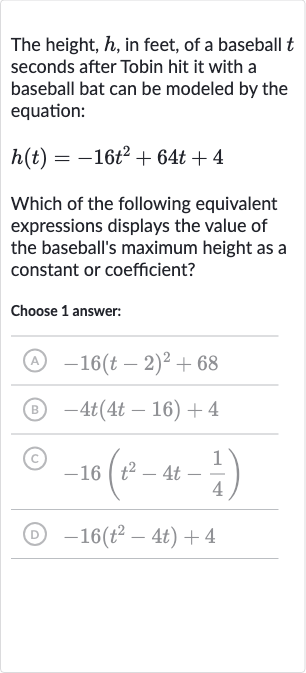AI tutor
Welcome to Bytelearn!
Let’s check out your problem:

The height, , in feet, of a baseball seconds after Tobin hit it with a baseball bat can be modeled by the equation:Which of the following equivalent expressions displays the value of the baseball's maximum height as a constant or coefficient?Choose answer:(A) (B) (C) (D)
Full solution
Q. The height, , in feet, of a baseball seconds after Tobin hit it with a baseball bat can be modeled by the equation:Which of the following equivalent expressions displays the value of the baseball's maximum height as a constant or coefficient?Choose answer:(A) (B) (C) (D)
- Problem Understanding: Understand the problem.We are given the quadratic equation , which models the height of a baseball seconds after being hit. We need to find an equivalent expression that shows the maximum height of the baseball as a constant or coefficient.
- Quadratic Equation Structure: Recognize the structure of the quadratic equation.The given equation is in the standard form of a quadratic equation, which is . The maximum height of the baseball will occur at the vertex of the parabola represented by this quadratic equation.
- Finding Time of Maximum Height: Find the time at which the maximum height occurs.The time at which the maximum height occurs can be found using the formula , where is the coefficient of and is the coefficient of in the quadratic equation.For our equation, and , so seconds.
- Writing Equation in Vertex Form: Write the equation in vertex form.The vertex form of a quadratic equation is , where is the vertex of the parabola. Since we know the time of the maximum height is seconds, we can write the equation as .
- Calculating Maximum Height: Calculate the maximum height . To find the value of , we substitute into the original equation . feet. So, the maximum height is feet.
- Final Vertex Form Equation: Write the final vertex form equation.Now that we have the value of , we can write the final vertex form equation as .
- Matching with Given Choices: Match the final vertex form equation with the given choices.The final vertex form equation we found is , which matches choice (A).
More problems from Interpret parts of quadratic expressions: word problems
QuestionGet tutor help
QuestionGet tutor help
QuestionGet tutor help
QuestionGet tutor help
QuestionGet tutor help
QuestionGet tutor help
QuestionGet tutor help
QuestionGet tutor help
